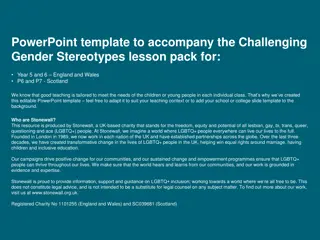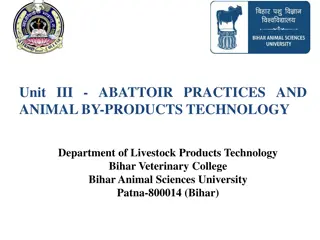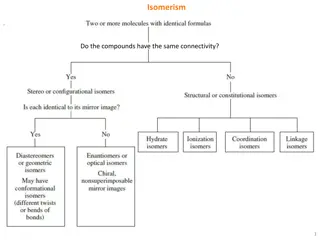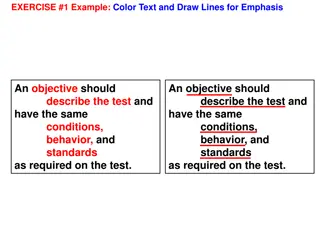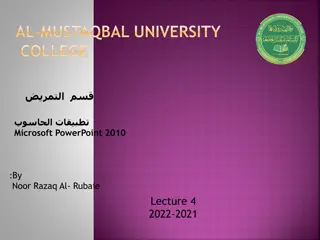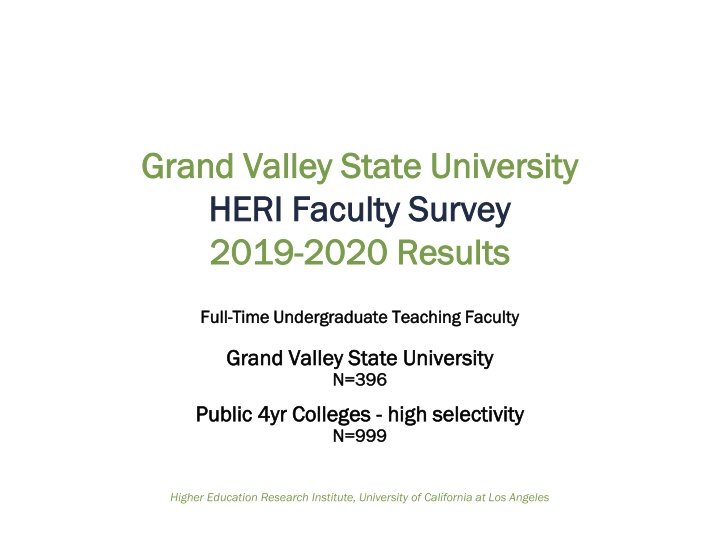
HERI Faculty Survey 2019-2020 Results at Grand Valley State University
Explore the results of the HERI Faculty Survey conducted at Grand Valley State University, highlighting key areas of faculty engagement in teaching, research, and service activities. The survey covers faculty experiences, satisfaction levels, workplace climate, teaching practices, sources of stress, research activities, and perspectives on campus climate and institutional priorities.
Download Presentation

Please find below an Image/Link to download the presentation.
The content on the website is provided AS IS for your information and personal use only. It may not be sold, licensed, or shared on other websites without obtaining consent from the author. If you encounter any issues during the download, it is possible that the publisher has removed the file from their server.
You are allowed to download the files provided on this website for personal or commercial use, subject to the condition that they are used lawfully. All files are the property of their respective owners.
The content on the website is provided AS IS for your information and personal use only. It may not be sold, licensed, or shared on other websites without obtaining consent from the author.
E N D
Presentation Transcript
Grand Valley State University Grand Valley State University HERI Faculty Survey HERI Faculty Survey 2019 2019- -2020 Results 2020 Results Full Full- -Time Undergraduate Teaching Faculty Time Undergraduate Teaching Faculty Grand Valley State University Grand Valley State University N=396 N=396 Public 4yr Colleges Public 4yr Colleges - - high selectivity N=999 N=999 high selectivity Higher Education Research Institute, University of California at Los Angeles
THE FACULTY EXPERIENCE Results from the HERI Faculty Survey Results from the HERI Faculty Survey highlight key areas of faculty s highlight key areas of faculty s engagement in teaching, research, and engagement in teaching, research, and service activities. The survey also service activities. The survey also touches on faculty s level of stress, touches on faculty s level of stress, satisfaction with their institution, and satisfaction with their institution, and perspectives for undergraduate perspectives for undergraduate education. education. Pedagogical practices Research and service activities Satisfaction and stress Institutional and departmental climate
Table of Contents Table of Contents Demographics Demographics Faculty Satisfaction Faculty Satisfaction Gender & Race/Ethnicity Gender & Race/Ethnicity Race/Ethnicity Race/Ethnicity Academic Department Academic Department Workplace Satisfaction Workplace Satisfaction Satisfaction with Compensation Satisfaction with Compensation Satisfaction with Pay Equity and Family Flexibility Satisfaction with Pay Equity and Family Flexibility Satisfaction with Relative Equity of Salary and Job Satisfaction with Relative Equity of Salary and Job Benefits, by Race/Ethnicity Benefits, by Race/Ethnicity Overall Satisfaction Overall Satisfaction Teaching Practices Teaching Practices Student Student- -Centered Pedagogy Centered Pedagogy Habits of Mind Habits of Mind Technology in the Classroom Technology in the Classroom Types of Courses Taught Types of Courses Taught Percent Teaching 3 or More Courses Percent Teaching 3 or More Courses this Term, by Rank this Term, by Rank Sources of Faculty Stress Sources of Faculty Stress Career Career- -Related Stress Related Stress Stress Due to Discrimination, by Gender Stress Due to Discrimination, by Gender Stress Due to Discrimination, by Race/Ethnicity Stress Due to Discrimination, by Race/Ethnicity Additional Sources of Stress Additional Sources of Stress Personal Sources of Stress Personal Sources of Stress Research Activities Research Activities Scholarly Productivity Scholarly Productivity Foci of Faculty Research Foci of Faculty Research Faculty Collaboration with Undergraduates Faculty Collaboration with Undergraduates Faculty Perspectives on Campus Climate Faculty Perspectives on Campus Climate Institutional Priority: Commitment to Diversity Institutional Priority: Commitment to Diversity Perspectives on Campus Climate for Diversity Perspectives on Campus Climate for Diversity Institutional Priority: Civic Engagement Institutional Priority: Civic Engagement Institutional Priority: Increasing Prestige Institutional Priority: Increasing Prestige Perspectives on Campus and Departmental Climate Perspectives on Campus and Departmental Climate Perspectives on Shared Governance Perspectives on Shared Governance Commitment to the Institution Commitment to the Institution 2019-2020 HERI Faculty Survey 3
A Note about HERI Constructs A Note about HERI Constructs We use the CIRP constructs throughout this We use the CIRP constructs throughout this PowerPoint to help summarize important PowerPoint to help summarize important information about your faculty from the HERI information about your faculty from the HERI Faculty Survey. Faculty Survey. Constructs Constructs Constructs tap into key features of the faculty experience by aggregating Constructs tap into key features of the faculty experience by aggregating questions from the HERI Faculty Survey. These faculty traits and questions from the HERI Faculty Survey. These faculty traits and institutional practices contribute to faculty s research productivity, overall institutional practices contribute to faculty s research productivity, overall satisfaction, and engagement with students in the classroom. satisfaction, and engagement with students in the classroom. Return to Table of Contents 2019-2020 HERI Faculty Survey 4 Return to Table of Contents Return to Table of Contents
Demographics Return to Table of Contents Return to Table of Contents Return to Table of Contents
Demographics Demographics Race/Ethnicity Gender 100% 90% 85.5% 80% 70% 60% 49.1% 50.9% 50% 40% 30% 20% 7.1% 10% 2.8% 2.1% 1.4% 1.1% 0.0% Man/Trans Man 0% Woman/Trans Woman Return to Table of Contents 2019-2020 HERI Faculty Survey 6 Return to Table of Contents Return to Table of Contents
Demographics Demographics Race/Ethnicity Comparison 7.1% Asian /Pacific Islander 9.4% 0.0% Native American/Alaska Native 0.0% 1.4% Black/African American 2.3% 2.1% Latina/o/x 4.2% 85.5% White 77.9% 1.1% Other Race/Ethnicity 1.8% 2.8% Two or More Races/Ethnicities 4.5% 0% 10% 20% 30% 40% 50% 60% 70% 80% 90% 100% Your Institution Comparison Group Return to Table of Contents 2019-2020 HERI Faculty Survey 7 Return to Table of Contents Return to Table of Contents
Demographics Demographics Academic Department (Aggregated) 1.5% Agriculture or Forestry 0.8% 7.4% Biological Sciences 8.5% 5.9% Business 3.1% 1.5% Education 4.6% 7.4% Engineering 1.5% 4.4% English 3.1% 0.0% Health-related 10.8% 4.4% History or Political Science 3.1% 8.1% Humanities 6.9% 3.7% Fine Arts 9.2% 10.4% Mathematics or Statistics 8.5% 8.9% Physical Sciences 9.2% 10.4% Social Sciences 13.1% 11.1% Other Technical 1.5% 14.8% Other Non-technical 16.2% 0% 10% 20% 30% 40% 50% 60% 70% 80% 90% 100% Men/Trans Men Women/Trans Women Return to Table of Contents 2019-2020 HERI Faculty Survey 8 Return to Table of Contents Return to Table of Contents
Teaching Practices Return to Table of Contents Return to Table of Contents Return to Table of Contents
Student Student- -Centered Pedagogy Centered Pedagogy Student-Centered Pedagogy measures the extent to which faculty use student-centered teaching and evaluation methods in their courses. 80 76 Construct Items 72 Student presentations Student evaluations of each others work Class discussions Cooperative learning (small groups) Experiential learning/Field studies Group projects Reflective writing/Journaling Using student inquiry to drive learning 68 64 60 56 53.5 53.5 52.0 52.0 50.5 52 50.2 48 44 40 All Faculty Men/Trans Men Women/Trans Women Your Institution Comparison Group Return to Table of Contents 2019-2020 HERI Faculty Survey 10 Return to Table of Contents Return to Table of Contents
Habits of Mind Habits of Mind These items measure the extent to which faculty structure courses to develop habits of mind for lifelong learning in students. 100% 90% 80% 47.5% 50.2% 70% 49.1% 52.5% 76.2% 60% 78.8% 76.3% 79.1% 77.4% 80.0% 50% 40% 30% 48.4% 45.8% 20% 37.2% 34.9% 22.1% 21.0% 10% 20.2% 20.0% 19.5% 17.8% 0% Support their opinions with a logical argument Seek solutions to problems and explain them to others Look up scientific research articles and resources Explore topics on their own, even though it was not required for class Accept mistakes as part of the learning process Your Institution Frequently Occasionally Comparison Group Frequently Occasionally Return to Table of Contents 2019-2020 HERI Faculty Survey 11 11 Return to Table of Contents Return to Table of Contents
Technology in the Classroom Technology in the Classroom Classrooms are becoming more technologically advanced, and faculty increasingly utilize new technologies to engage students. 100% 90% 80% 70% 46.4% 46.8% 60% 21.3% 19.5% 19.6% 36.4% 34.0% 50% 18.4% 40% 30% 8.8% 8.2% 46.0% 43.1% 42.7% 42.3% 41.9% 20% 39.3% 34.5% 33.4% 21.5% 10% 19.9% 0% Videos or podcasts Simulations/animations Online homework or virtual labs Online discussion boards Audience response systems to gauge students understanding (e.g., clickers) Your Institution Frequently Occasionally Comparison Group Frequently Occasionally Return to Table of Contents 2019-2020 HERI Faculty Survey 12 12 Return to Table of Contents Return to Table of Contents
Types of Courses Taught Types of Courses Taught During the Past Three Years During the Past Three Years 100% 90% 80% 70% 60% 50% 40% 30% 20% 10% 19.2% 17.3% 16.4% 16.4% 14.2% 12.7% 11.9% 11.1% 0% Honors course Seminar for first-year students Area studies course (e.g., women's studies, ethnic studies, LGBTQ+ studies) Service-learning course Your Institution Comparison Group Return to Table of Contents 2019-2020 HERI Faculty Survey 13 13 Return to Table of Contents Return to Table of Contents
Percent Teaching 3 or More Courses Percent Teaching 3 or More Courses this Term, by Rank this Term, by Rank 100% 80% 63.9% 60.9% 60% 40% 30.7% 25.6% 23.7% 23.4% 20% 15.4% 9.9% 0% Lecturer/Instructor Assistant Professor Associate Professor Professor Your Institution Comparison Group Return to Table of Contents 2019-2020 HERI Faculty Survey 14 14 Return to Table of Contents Return to Table of Contents
Research Activities Return to Table of Contents Return to Table of Contents Return to Table of Contents
Scholarly Productivity Scholarly Productivity A unified measure of the scholarly activity of faculty 60 58 56 Construct Items 54 52.0 Articles in academic and professional journals Chapters in edited volumes Professional writings published or accepted for publication in the last three years 52 50.5 50.3 49.6 50 48.8 48.8 48 46 44 42 40 All Faculty Men/Trans Men Women/Trans Women Your Institution Comparison Group Return to Table of Contents 2019-2020 HERI Faculty Survey 16 16 Return to Table of Contents Return to Table of Contents
Foci of Faculty Research Foci of Faculty Research 100% 90% 80% 70% 60% 50% 40% 65.9% 65.5% 30% 20% 34.1% 34.0% 27.8% 26.8% 24.2% 23.5% 10% 0% Conducted research or writing focused on international/global issues Conducted research or writing focused on racial or ethnic minorities Conducted research or writing focused on women or gender issues Engaged in academic research that spans multiple disciplines Your Institution Comparison Group Return to Table of Contents 2019-2020 HERI Faculty Survey 17 17 Return to Table of Contents Return to Table of Contents
Faculty Collaboration with Undergraduates Faculty Collaboration with Undergraduates With undergraduate research becoming a priority at many campuses, faculty are increasingly being asked to work with undergraduates on research projects. 100% 90% 80% 70% 60% 50% 40% 30% 13.3% 15.9% 20% 12.4% 11.4% 10% 18.0% 16.2% 6.7% 6.1% 9.9% 9.2% 4.8% 4.5% 0% Engaged undergraduates on your research project(s) Worked with undergraduates on their research project(s) Presented with undergraduate students at conferences Your Institution Very Large Extent Large Extent Comparison Group Very Large Extent Large Extent Return to Table of Contents 2019-2020 HERI Faculty Survey 18 18 Return to Table of Contents Return to Table of Contents
Faculty Satisfaction Return to Table of Contents Return to Table of Contents Return to Table of Contents
Workplace Satisfaction Workplace Satisfaction 100% 90% 80% 70% 41.6% 42.2% 17.0% 60% 24.6% 33.2% 39.0% 26.4% 50% 11.3% 40% 30% 54.3% 43.3% 43.0% 42.6% 42.5% 20% 38.9% 38.1% 34.3% 10% 0% Autonomy and independence Teaching load Departmental leadership Departmental support for work/life balance Your Institution Very Satisfied Satisfied Comparison Group Very Satisfied Satisfied Return to Table of Contents 2019-2020 HERI Faculty Survey 20 20 Return to Table of Contents Return to Table of Contents
Satisfaction with Compensation Satisfaction with Compensation 100% 90% 80% 70% 40.6% 19.2% 29.5% 60% 18.8% 18.9% 12.5% 50% 9.8% 9.4% 40% 30% 53.1% 49.4% 49.1% 48.0% 47.6% 44.4% 41.4% 40.8% 20% 10% 0% Salary Retirement benefits Opportunity for scholarly pursuits Leave policies (e.g., paternity/maternity leave, caring for a family member, stopping the tenure clock) Your Institution Very Satisfied Satisfied Comparison Group Very Satisfied Satisfied Return to Table of Contents 2019-2020 HERI Faculty Survey 21 21 Return to Table of Contents Return to Table of Contents
Satisfaction with Pay Equity and Family Flexibility Satisfaction with Pay Equity and Family Flexibility 100% 90% 80% 70% 28.0% 33.1% 21.4% 38.6% 60% 12.8% 50% 8.0% 40% 30% 56.0% 53.3% 50.3% 46.0% 43.8% 20% 38.1% 10% 0% Relative equity of salary and job benefits Flexibility in relation to family matters or emergencies Overall job Your Institution Very Satisfied Satisfied Comparison Group Very Satisfied Satisfied Return to Table of Contents 2019-2020 HERI Faculty Survey 22 22 Return to Table of Contents Return to Table of Contents
Satisfaction with Relative Equity of Salary Satisfaction with Relative Equity of Salary and Job Benefits, by Race/Ethnicity and Job Benefits, by Race/Ethnicity Race Your Institution Comparison Group Native American/Alaska Native Very Satisfied Satisfied Asian/Pacific Islander Very Satisfied Satisfied Black/African American Very Satisfied Satisfied Latina/o/x Very Satisfied Satisfied White Very Satisfied Satisfied Other Race/Ethnicity Very Satisfied Satisfied Two or more Races/Ethnicities Very Satisfied Satisfied -- -- -- -- 5.3% 73.7% 4.3% 47.8% -- -- 0.0% 37.5% 16.7% 83.3% 10.3% 41.4% 14.0% 40.7% 8.6% 36.8% -- -- 0.0% 38.5% 12.5% 62.5% 12.1% 39.4% Return to Table of Contents 2019-2020 HERI Faculty Survey 23 Return to Table of Contents Return to Table of Contents
Overall Satisfaction Overall Satisfaction If given the choice, would you still come to this institution? 100% 90% 80% 70% 60% 50% 45.0% 43.8% 40% 35.7% 35.2% 30% 20% 14.1% 13.3% 10% 5.1% 3.1% 2.5% 2.1% 0% Definitely Yes Probably Yes Not Sure Probably No Definitely No Your Institution Comparison Group Return to Table of Contents 2019-2020 HERI Faculty Survey 24 24 Return to Table of Contents Return to Table of Contents
Sources of Faculty Stress Return to Table of Contents Return to Table of Contents Return to Table of Contents
Career Career- -Related Stress Related Stress Career-Related Stress measures the amount of stress faculty experience related to their career. 80 76 Construct Items 72 Committee work Students Research or publishing demands Institutional procedures and red tape Teaching load Lack of personal time Self-imposed high expectations 68 64 60 56 52.5 52.0 51.6 51.0 50.7 52 50.0 48 44 40 All Faculty Men/Trans Men Women/Trans Women Your Institution Comparison Group Return to Table of Contents 2019-2020 HERI Faculty Survey 26 26 Return to Table of Contents Return to Table of Contents
Stress Due to Discrimination, by Gender Stress Due to Discrimination, by Gender 100% 90% 80% 70% 60% 50% 40% 13.7% 12.8% 30% 9.0% 10.2% 20% 5.0% 4.3% 32.3% 32.2% 24.2% 23.5% 10% 15.8% 14.7% 0% All Faculty Men/Trans Men Women/Trans Women Your Institution Extensive Somewhat Comparison Group Extensive Somewhat Return to Table of Contents 2019-2020 HERI Faculty Survey 27 27 Return to Table of Contents Return to Table of Contents
Stress Due to Discrimination, by Race/Ethnicity Stress Due to Discrimination, by Race/Ethnicity Race Your Institution Comp Group Native American/Alaska Native Extensive Somewhat Asian/Pacific Islander Extensive Somewhat Black/African American Extensive Somewhat Latina/o/x Extensive Somewhat White Extensive Somewhat Other Race/Ethnicity Extensive Somewhat Two or more Races/Ethnicities Extensive Somewhat -- -- -- -- 5.9% 29.4% 6.5% 32.3% -- -- 20.0% 53.3% -- -- 14.8% 33.3% 9.9% 21.2% 7.4% 21.1% -- -- 33.3% 33.3% 14.3% 42.9% 12.9% 25.8% Return to Table of Contents 2019-2020 HERI Faculty Survey 28 Return to Table of Contents Return to Table of Contents
Additional Sources of Stress Additional Sources of Stress 100% 90% 80% 70% 18.6% 28.6% 22.5% 28.9% 28.3% 60% 16.7% 19.6% 50% 21.3% 40% 30% 9.1% 54.9% 50.0% 49.9% 49.3% 46.3% 46.2% 8.4% 40.8% 20% 37.7% 23.6% 10% 17.1% 0% Research or publishing demands Review/promotion process Job security Increased work responsibilities Institutional budget cuts Your Institution Extensive Somewhat Comparison Group Extensive Somewhat Return to Table of Contents 2019-2020 HERI Faculty Survey 29 29 Return to Table of Contents Return to Table of Contents
Personal Sources of Stress Personal Sources of Stress 100% 90% 80% 70% 21.1% 23.3% 26.7% 17.4% 18.3% 60% 30.6% 14.5% 13.6% 50% 40% 30% 57.3% 54.4% 52.1% 51.4% 50.2% 50.2% 49.4% 44.7% 20% 10% 0% My emotional well-being My physical health Lack of personal time Managing household responsibilities Your Institution Extensive Somewhat Comparison Group Extensive Somewhat Return to Table of Contents 2019-2020 HERI Faculty Survey 30 30 Return to Table of Contents Return to Table of Contents
Faculty Perspectives on Campus Climate Return to Table of Contents Return to Table of Contents Return to Table of Contents
Institutional Priority: Commitment to Diversity Institutional Priority: Commitment to Diversity 100% 90% 80% 70% 60% 50% 13.4% 15.8% 16.2% 15.5% 20.4% 16.2% 40% 30% 20% 40.0% 38.7% 37.8% 37.8% 34.9% 33.3% 10% 0% Recruit more traditionally Promote gender diversity in the Promote racial and ethnic diversity underrepresented students faculty and administration in the faculty and administration Your Institution Highest Priority High Priority Comparison Group Highest Priority High Priority Return to Table of Contents 2019-2020 HERI Faculty Survey 32 32 Return to Table of Contents Return to Table of Contents
Perspectives on Campus Climate for Diversity Perspectives on Campus Climate for Diversity 100% 90% 80% 70% 19.5% 22.4% 60% 15.7% 19.5% 10.5% 50% 10.9% 40% 30% 58.6% 51.4% 50.2% 49.8% 46.1% 44.5% 20% 10% 0% This institution has effective hiring practices and policies that increase faculty diversity This institution takes responsibility for educating underprepared students Faculty are not prepared to deal with conflict over diversity issues in the classroom Your Institution Strongly Agree Somewhat Agree Comparison Group Strongly Agree Somewhat Agree Return to Table of Contents 2019-2020 HERI Faculty Survey 33 33 Return to Table of Contents Return to Table of Contents
Institutional Priority: Civic Engagement Institutional Priority: Civic Engagement Civic Engagement measures the extent to which faculty believe their institution is committed to facilitating civic engagement among students and faculty. 80 76 Construct Items 72 Facilitate student involvement in community service Provide resources for faculty to engage in community-based teaching or research Create and sustain partnerships with surrounding communities 68 64 60 56 51.5 51.5 51.3 52 50.2 50.0 49.9 48 44 40 All Faculty Men/Trans Men Women/Trans Women Your Institution Comparison Group Return to Table of Contents 2019-2020 HERI Faculty Survey 34 34 Return to Table of Contents Return to Table of Contents
Institutional Priority: Increasing Prestige Institutional Priority: Increasing Prestige 100% 90% 80% 70% 60% 20.6% 50% 13.1% 40% 30% 5.0% 43.5% 43.4% 20% 4.1% 3.1% 0.7% 10% 19.3% 14.7% 12.5% 11.7% 0% Increase or maintain institutional prestige Hire faculty stars Increase the selectivity of the student body through more competitive admissions criteria Your Institution Highest Priority High Priority Comparison Group Highest Priority High Priority Return to Table of Contents 2019-2020 HERI Faculty Survey 35 35 Return to Table of Contents Return to Table of Contents
Perspectives on Perspectives on Campus and Departmental Climate Campus and Departmental Climate 100% 90% 80% 70% 51.5% 52.8% 60% 46.7% 29.9% 26.9% 41.6% 50% 40% 30% 4.3% 44.5% 44.0% 5.1% 20% 37.0% 37.0% 36.6% 36.1% 21.1% 10% 18.2% 0% There is a lot of campus racial conflict here My research is valued by faculty in my department My service is valued by faculty in my department My teaching is valued by faculty in my department Your Institution Strongly Agree Somewhat Agree Comparison Group Strongly Agree Somewhat Agree Return to Table of Contents 2019-2020 HERI Faculty Survey 36 36 Return to Table of Contents Return to Table of Contents
Perspectives on Shared Governance Perspectives on Shared Governance 100% 90% 80% 70% 15.5% 60% 11.0% 13.9% 10.2% 50% 12.6% 40% 4.0% 30% 54.5% 53.5% 51.3% 48.3% 20% 37.9% 29.9% 10% 0% Faculty are sufficiently involved in campus decision-making The faculty are typically at odds with campus administration Administrators consider faculty concerns when making policy Your Institution Strongly Agree Somewhat Agree Comparison Group Strongly Agree Somewhat Agree Return to Table of Contents 2019-2020 HERI Faculty Survey 37 37 Return to Table of Contents Return to Table of Contents
Commitment to the Institution Commitment to the Institution Percentage of respondents who replied Yes 100% 90% 80% 70% 60% 50% 40% 30% 44.2% 41.4% 20% 39.7% 37.3% 10% 11.2% 9.4% 0% In the past year, have you considered leaving academe for another job? In the past year, have you considered leaving this institution for another? Do you plan to retire within the next three years? Your Institution Comparison Group Return to Table of Contents 2019-2020 HERI Faculty Survey 38 38 Return to Table of Contents Return to Table of Contents
The more you get to know your faculty, the better you can understand their needs. For more information about HERI/CIRP Surveys The Freshman Survey Your First College Year Survey Diverse Learning Environments Survey College Senior Survey The Faculty Survey Staff Climate Survey Please contact: heri@ucla.edu (310) 825-1925 www.heri.ucla.edu

